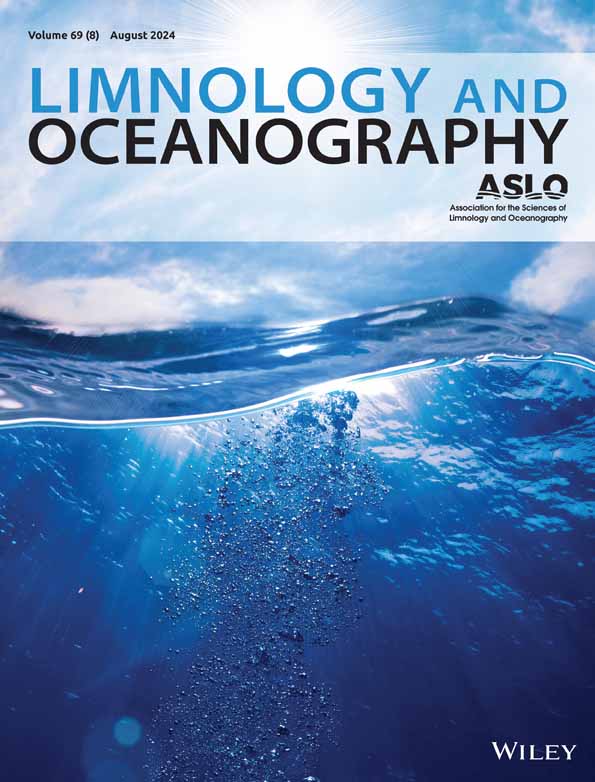proactinium‐231和钍‐230的分布证实了印度洋经向翻转环流的关键影响
IF 3.8
1区 地球科学
Q1 LIMNOLOGY
引用次数: 0
摘要
沉积231Pa/230Th已被用作了解末次冰期-间冰期旋回海洋环流和生产力变化的替代指标。其应用依赖于经向翻转环流(MOC)和粒子清除对水柱和沉积物中231Pa和230Th分布的影响。虽然以前的研究已经解决了MOC对大西洋和太平洋230和231Pa水剖面和沉积231Pa/230的作用,包括后者的边界清除的影响,但这些过程对印度洋的影响仍未解决。本文采用具有规定翻转方案的二维扫气模式,模拟了印度洋水柱和沉积物中230Th和231Pa的纬向分布。两种核素的水柱剖面均偏离线性,反映了MOC控制下的深层对流、平流和上升流的影响。此外,球状层内的底部清除和边界清除显著地消耗了马达加斯加盆地的231Pa。主要盆地1500 m以下沉积物231Pa/230Th的逐渐减少主要与MOC有关,而边界清除则有助于系统地降低231Pa/230Th。这些发现表明,沉积231Pa/230Th可能作为研究印度洋深海环流和颗粒通量变化的代理。本文章由计算机程序翻译,如有差异,请以英文原文为准。
Distributions of Protactinium‐231 and Thorium‐230 confirm the critical influence of meridional overturning circulation in the Indian Ocean
Sedimentary 231 Pa/230 Th has been used as a proxy for understanding changes in ocean circulation and productivity over the last glacial–interglacial cycle. Its application relies on the influence of meridional overturning circulation (MOC) and particle scavenging on the distribution of 231 Pa and 230 Th in the water column and sediments. While previous studies have addressed the role of MOC on the 230 Th and 231 Pa water profiles and sedimentary 231 Pa/230 Th in the Atlantic and Pacific Oceans, including the influence of boundary scavenging in the latter, the impact of these processes in the Indian Ocean remains unresolved. This study employs a two‐dimensional scavenging model with prescribed overturning schemes to simulate the latitudinal distribution of 230 Th and 231 Pa in the water column and sediments of the Indian Ocean. The water column profiles of both nuclides deviate from linearity, reflecting the influence of deep convection, advection, and upwelling controlled by MOC. Additionally, bottom scavenging within the nepheloid layer and boundary scavenging significantly depletes 231 Pa in the Madagascar Basin. The gradual decrease in sediment 231 Pa/230 Th below 1500 m in the main basins is primarily linked to MOC, while boundary scavenging contributes to systematically lowering the 231 Pa/230 Th. These findings point to the potential of sedimentary 231 Pa/230 Th as a proxy for studying the alteration of deep ocean circulation and particle flux in the Indian Ocean.
求助全文
通过发布文献求助,成功后即可免费获取论文全文。
去求助
来源期刊

Limnology and Oceanography
地学-海洋学
CiteScore
8.80
自引率
6.70%
发文量
254
审稿时长
3 months
期刊介绍:
Limnology and Oceanography (L&O; print ISSN 0024-3590, online ISSN 1939-5590) publishes original articles, including scholarly reviews, about all aspects of limnology and oceanography. The journal''s unifying theme is the understanding of aquatic systems. Submissions are judged on the originality of their data, interpretations, and ideas, and on the degree to which they can be generalized beyond the particular aquatic system examined. Laboratory and modeling studies must demonstrate relevance to field environments; typically this means that they are bolstered by substantial "real-world" data. Few purely theoretical or purely empirical papers are accepted for review.
 求助内容:
求助内容: 应助结果提醒方式:
应助结果提醒方式:


